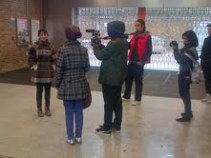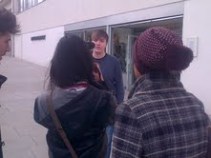One of EOTO’s (the charity set up by Plan B) ideas is that young people should teach other young people. It makes sense.
Very pleased to still be considered a ‘young person’, I was happy to get involved with the EOTO Media training programme. Here’s the idea:
EOTO Media offers young people a series of FREE media training workshops led by young industry professionals, who help them to identify and develop their talent through exciting and innovative projects. The content created is then published on their personal EOTO Media profile, giving members the platform to showcase their talent to the world.
Workshops are currently offered in Photography, Video Production and Journalism.
For the past 6 weeks, I’ve been doing some journalism workshops with young people who were interested in the industry but lacked the experience and confidence to break into it. After a short course, spread over 6 weekends, my students had each researched, reported on and self-produced a brand new story on a local issue that mattered to them and their community. See their work here:
http://eototrust.org/journalism/
The exciting thing is that their work doesn’t stop here. They now have a platform to create and showcase their work via the EOTO website. An online showreel / CV for potential employers to look at and a way to let the world know what young people really care about.













